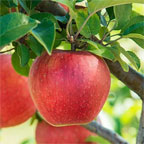- Q.SUGAR APPLE POLLINATION/ REPLY PLEASE - I HAVE HEARD THAT SUGAR APPLE TREE NEEDS HAND POLLINATION. I HAVE 3 OVER 2 YEARS YOUNG PLANTS. I AM ...
- Q.Why Can’t My Sugar Apple Bear Fruit? I Can See It Flowering But Never See Any Fruit. - my email address is seanyong88@yahoo.com
- Q.To Increase Yield - How to increase fruit yield of annona reticulata?
- Q.What Is The Cause Of Brown Spots On My Seedlings? - I am growing sugar apple seedlings, they are about 3 months old. I noticed recently that some of them started ...
- Q.Photo Shown In Amy Grant Article Is C. Squamosa And Not C. Cherimola, Correct? - I'm fairly certain that your onsite article by Amy Grant "What is a Cherimoya?" Is showing a photo of an ...
Q.SUGAR APPLE POLLINATION/ REPLY PLEASE
I HAVE HEARD THAT SUGAR APPLE TREE NEEDS HAND POLLINATION. I HAVE 3 OVER 2 YEARS YOUNG PLANTS. I AM IN ZONE 9 TEXAS. ALL THREE PLANTS HAVE SO MANY FLOWERS THIS YEAR. BUT THEY JUST GET DRIED OUT AND WILL FALL OFF AFTER DRYING OUT. I HAVE WATCHED HAND POLLINATION ON YOU TUBE AND IT SEEMS VERY HARD AND CONFUSING FOR ME. CAN ANYONE PLEASE TELL ME? CAN I GET FRUITS WITHOUT HAND POLLINATION FROM THESE PLANTS? I MEAN IF I LEAVE THEM ALONE NEXT YEAR THEY WILL BE MORE MATURE THEN WOULD THEY PRODUCE SOME FRUITS?? PLEASE ADVISE
- A.
Hand pollination of sugar apple is possible and may be very effective in improving fruit set (up to nearly 100%) and fruit shape. In general, pollen is collected from stamens of flowers in the male stage, which may be late afternoon, early evening, and early morning. The collected flower may be placed on paper where the anthers (male flower parts) are allowed to dehisce (release pollen). The next morning the pollen may be mixed with talcum powder to improve handling and transferred to flowers in the female stage of development. Hand pollination is usually most successful in the early to mid-morning hours (sunrise to about 11:00 am) and is done by using a thin paint brush (like the brush found in water color paint set) to transfer pollen through the slightly open flower petals of the female stage flowers to the stigmatic surfaces at the base of the flower.
Was this answer useful?00
Q.Why can’t my sugar apple bear fruit? I can see it flowering but never see any fruit.
my email address is seanyong88@yahoo.com
- A.
Often, this is related to a lack of fertilization. More specifically, a lack of phosphorus and potassium. This article will help you with the care of these: https://www.gardeningknowhow.com/ornamental/trees/annona/sugar-apple-trees.htm
Was this answer useful?00 Q.To increase yield
How to increase fruit yield of annona reticulata?
- A.
Yield is directly related to seed or hybrid plant selection, comprehensive plant health care including appropriate species selection for the climate and the site conditions, compatible plantings, soil fertility and water management.
If you are growing commercially, then soil analysis and prescription amendments based on actual deficiencies found will be a good investment and essential for soil fertility management, pest and disease resistance, yield, size and taste.
A local university/county agricultural extension service can be a good resource.General requirements for A. reticulata are similar to other species of the Annona genus, with some tips in these articles.
https://www.gardeningknowhow.com/edible/fruits/soursop/soursop-tree-care.htm
https://www.gardeningknowhow.com/ornamental/trees/annona/sugar-apple-trees.htmWas this answer useful?00 Q.What Is The Cause Of Brown Spots On My Seedlings?
I am growing sugar apple seedlings, they are about 3 months old. I noticed recently that some of them started developing brown or yellow spots on the leaves? What is that? One of the seedlings ended up with dried leaves. Is it caused by fungus? Or insects?
- A.
Most likely too much water. Try cutting back on the water, let the soil dry before watering again. Increase air circulation such as with a fan, and provide bright, indirect light.
https://www.gardeningknowhow.com/garden-how-to/propagation/seeds/troubleshooting-seedling-issues.htm
https://www.gardeningknowhow.com/ornamental/trees/annona/sugar-apple-trees.htm
Was this answer useful?00 Q.Photo Shown In Amy Grant Article Is C. Squamosa And Not C. Cherimola, Correct?
I'm fairly certain that your onsite article by Amy Grant "What is a Cherimoya?" Is showing a photo of an Annona squamosa. Cherimoya = Annona cherimola. So far as I can discern, Cherimoya and Custard apple are two different fruits, same genus but different species. Correct?
- A.
I asked this question and put C. cherimola and C. squamosa in my "details." My error: It is Annona cherimoya and A. squamosa.
Was this answer useful?00



